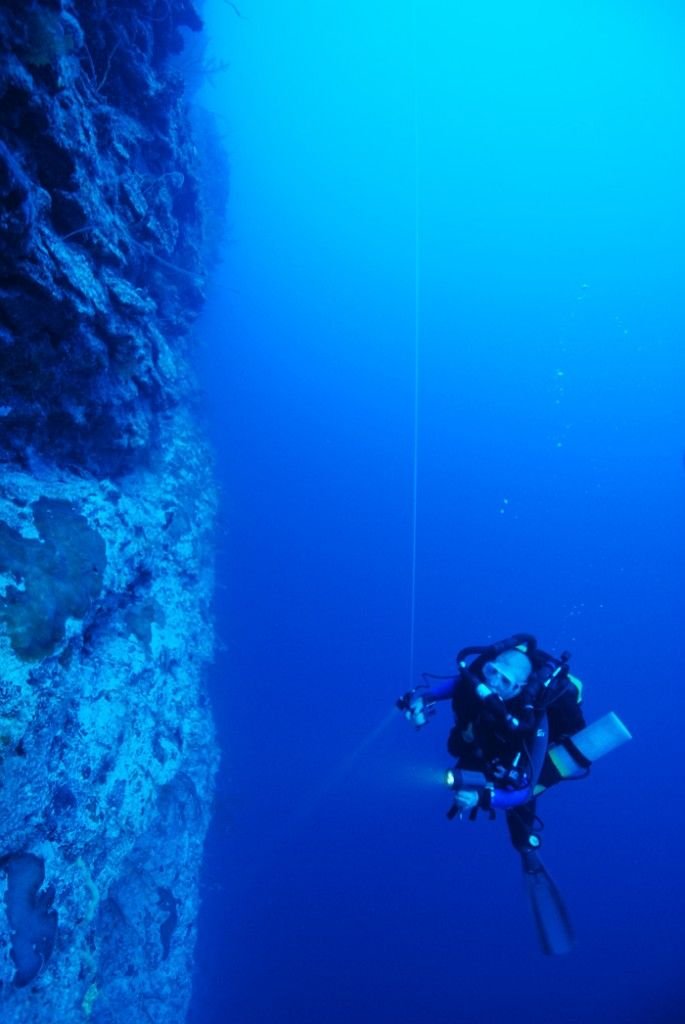Introduction: Into the Depths of Darkness
Beneath the sunlit surface of the world’s oceans lies a realm of mystery and extremes — a world where sunlight never penetrates, pressure can crush steel, and temperatures hover near freezing. This is the abyss, the deep ocean zone that begins roughly 4,000 meters below the surface and extends to the ocean floor. For centuries, this vast, dark world remained unexplored, leading many to believe it was lifeless and barren. But modern science has proven otherwise. Far from being empty, the abyss is teeming with life — strange, beautiful, and resilient creatures that defy imagination and challenge our understanding of biology itself.
The journey to the abyss is more than a descent into darkness — it’s an expedition into Earth’s most alien environment, where survival depends on adaptations so extraordinary they seem almost otherworldly.
The Abyssal Zone: Earth’s Final Frontier
The deep ocean is divided into several zones, each defined by depth, light, and pressure. After the twilight region known as the mesopelagic zone, the light fades completely. Below 4,000 meters lies the abyssal zone, covering more than 60% of the ocean floor. This vast area is one of the least explored environments on Earth.
In the abyss, no sunlight reaches, meaning photosynthesis — the process that fuels most life on the surface — is impossible. Temperatures average just 2°C, and the pressure can exceed 600 times that at sea level. Yet, despite these harsh conditions, countless species thrive here. From glowing jellyfish to giant tube worms, the creatures of the abyss have evolved unique ways to survive and even flourish in a world of perpetual night.
How Scientists Explore the Deep Ocean
Exploring the abyss is one of the greatest technological challenges in science. The crushing pressure and complete darkness make human exploration nearly impossible without specialized equipment. Over the years, scientists have developed advanced tools and vehicles to reach these hidden depths.
1. Submersibles and Deep-Diving Vehicles
Pioneers like Jacques Piccard and Don Walsh first reached the deepest part of the ocean, the Mariana Trench, in 1960 aboard the submersible Trieste. Modern submersibles, such as DSV Limiting Factor and Alvin, are equipped with titanium hulls, robotic arms, and high-definition cameras, allowing scientists to study deep-sea environments firsthand.
2. Remote and Autonomous Underwater Vehicles (ROVs & AUVs)
Because manned missions are rare and costly, remotely operated vehicles (ROVs) and autonomous underwater vehicles (AUVs) have become essential tools. They can dive thousands of meters, collect samples, and capture detailed images of life on the seafloor.
3. Sonar and Bioluminescent Imaging
Scientists use sonar to map the deep-sea terrain, while new imaging systems can detect the faint glow of bioluminescent organisms that light up the darkness. These technologies have revolutionized our understanding of what lies beneath.
Through these innovations, the deep ocean is no longer completely hidden — it is slowly revealing its secrets.
Life Without Sunlight: The Miracle of Chemosynthesis
In most ecosystems, life depends on sunlight as the primary energy source. But in the abyss, where sunlight never reaches, life has found another way to survive — through chemosynthesis.
At hydrothermal vents along the ocean floor, seawater seeps into cracks in the Earth’s crust, becomes superheated by magma, and emerges rich in minerals like hydrogen sulfide. Instead of sunlight, bacteria use these chemicals to produce energy, forming the base of an entirely new food chain.
These microscopic organisms support entire communities of strange creatures — including giant tube worms, vent crabs, and blind shrimp — living in complete darkness. Some tube worms grow over two meters long and have no mouth or stomach; they rely entirely on symbiotic bacteria within their bodies to convert toxic chemicals into food.
This discovery, first made in 1977 near the Galápagos Rift, revolutionized biology. It proved that life could exist independently of sunlight, reshaping our understanding of where and how life can exist — even beyond Earth.
The Creatures of the Abyss: Nature’s Hidden Wonders
The deep ocean is home to some of the most extraordinary life forms on Earth. Every year, scientists discover hundreds of new species, many of which look like they belong in science fiction rather than reality.
1. The Anglerfish
One of the most iconic deep-sea creatures, the anglerfish, uses a glowing lure on its head to attract prey in the darkness. Its enormous mouth and sharp teeth allow it to swallow fish nearly its own size. The females are much larger than the males, which live as tiny parasites fused to their bodies — a bizarre example of adaptation for survival.
2. The Giant Squid and the Colossal Squid
Long considered a myth, the giant squid (Architeuthis dux) is a real deep-sea predator reaching lengths of over 12 meters. Even larger is the colossal squid, found in Antarctic waters, with eyes the size of dinner plates — the largest eyes in the animal kingdom.
3. The Vampire Squid
Despite its name, the vampire squid does not suck blood. Instead, it feeds on “marine snow” — the falling organic debris from upper ocean layers. With its webbed arms and bioluminescent body, it floats gracefully in the abyss, a haunting yet mesmerizing sight.
4. The Dumbo Octopus
Named for its ear-like fins, the Dumbo octopus flaps through the deep sea like a tiny ghost. It can survive at depths of over 7,000 meters, making it one of the deepest-living octopuses known.
Each of these species tells a story of evolution’s creativity — proof that even in the most extreme environments, life finds a way.
The Role of Bioluminescence: Light in the Darkness
In the pitch-black world of the deep ocean, light becomes a language. Many abyssal creatures produce their own light through chemical reactions — a phenomenon known as bioluminescence.
Fish, jellyfish, squid, and even bacteria use bioluminescence to communicate, camouflage, lure prey, or deter predators. The lanternfish, for example, uses light organs to blend in with faint light from above, while the dragonfish can emit red light — invisible to most sea creatures — giving it a secret advantage in hunting.
Bioluminescence is one of the most mesmerizing features of the deep sea. Scientists believe up to 90% of deep-sea species have some form of light-producing ability, making the abyss a world not of darkness, but of shimmering, living light.
Discoveries That Changed Our Understanding of Life
The discovery of hydrothermal vents and the diverse ecosystems surrounding them has redefined what we know about life on Earth. These findings suggest that life could potentially exist in similar conditions elsewhere — such as beneath the icy crusts of Europa (a moon of Jupiter) or Enceladus (a moon of Saturn), where liquid oceans may lie hidden below the surface.
Studying these deep-sea ecosystems also provides insight into Earth’s earliest life forms. Many scientists believe that life on Earth may have begun near hydrothermal vents billions of years ago, where the chemical-rich environment could have provided the perfect conditions for the first organisms to emerge.
Thus, the abyss is not just a place of mystery — it is a window into our planet’s ancient past and a guide to where life might be found beyond Earth.
Threats to the Deep Ocean: A Fragile World at Risk
Despite being remote and seemingly untouched, the deep ocean faces increasing threats from human activity. Deep-sea mining, pollution, and climate change are all putting pressure on fragile ecosystems that took millennia to develop.
Plastic pollution has been found even in the deepest trenches, and the noise from ships and drilling disrupts the natural soundscape of marine life. Deep-sea mining for valuable minerals like cobalt and manganese poses an even greater risk — potentially destroying habitats before we’ve had the chance to study them.
The challenge is that the deep sea is difficult to monitor and even harder to restore. Once damaged, its ecosystems may take centuries to recover. That’s why mapping, monitoring, and protecting the abyss are more important than ever.
The Future of Deep Ocean Exploration
New technology is opening unprecedented possibilities for deep-sea exploration. Advanced autonomous robots, AI-driven data analysis, and long-duration submersibles are enabling scientists to explore more of the abyss than ever before.
International projects like Seabed 2030 aim to map the entire ocean floor by the end of this decade, providing a foundation for both discovery and conservation. Private expeditions and collaborations between governments, research institutions, and ocean foundations are bringing renewed attention to the importance of the deep sea.
The next generation of explorers may not walk on the surface of Mars first — they may instead travel through the crushing darkness of the abyss, uncovering new forms of life right here on Earth.
Conclusion: The Living Heart of the Ocean
The deep ocean remains one of Earth’s greatest mysteries — a world of eternal night, where life glows, grows, and adapts in ways that defy the imagination. Each new dive reveals something astonishing: new species, strange behaviors, and entire ecosystems that challenge the boundaries of science.
Exploring the abyss is not just about discovery — it’s about understanding the delicate balance of our planet’s life systems. The creatures of the deep remind us that even in the harshest conditions, life endures and thrives.
As humanity continues its journey into the abyss, one truth becomes clear: the dark ocean is not lifeless — it is alive with secrets, beauty, and resilience. To explore it is to rediscover the wonder of our own planet, and to protect it is to secure the future of life on Earth.


